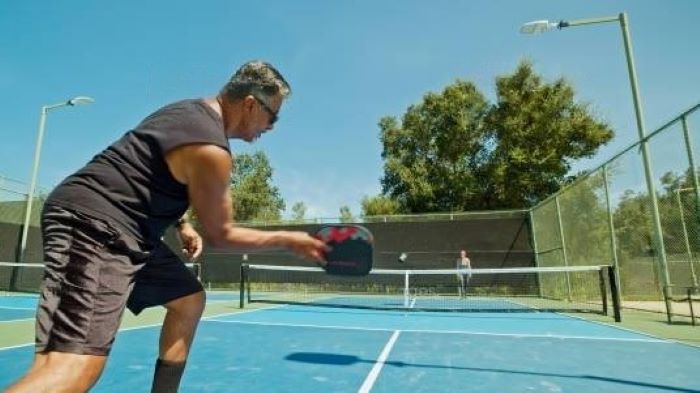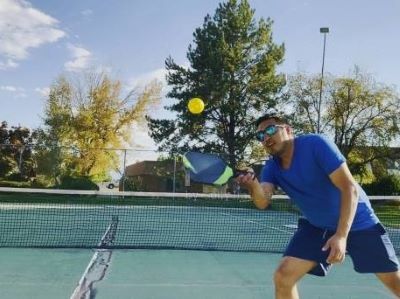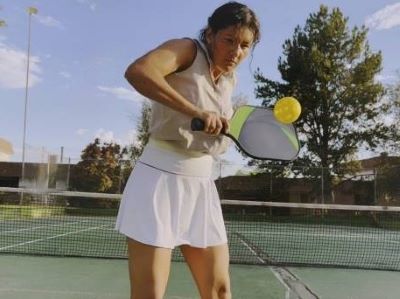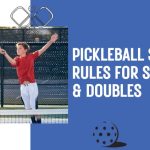Are you new to pickleball and wondering what people mean when they talk about a “rally”? Or you’re an experienced player looking to improve your terminology. Either way, understanding the concept of a rally is essential for playing this exciting sport.

In this blog post, we’ll dive into everything you need to know about rallies in pickleball – from how they’re defined to tips for extending them and winning more points. So grab your paddle, and let’s get started!
What Is Rally Scoring in Pickleball?
It is essential to comprehend the concept of a “rally” in pickleball to keep up with the more rapid rallies that have become commonplace. A rally is a back-and-forth that occurs after the ball is served but before a fault is declared. To put it simply, a rally is what transpires on the court after the ball is served.
As these rallies become increasingly vigorous, games may take longer to finish in the traditional pickleball scoring system, where a point can only be earned while possessing the serve. It can take a while for either side to score. For instance, if the two teams are evenly matched, it may take multiple rallies before either team can score a point.
Pros of Rally in Pickleball
In pickleball, the rally has the following advantages:

- The great thing about rally scoring in pickleball is that it speeds up the game, which is perfect for busy or crowded courts. This way, more people can get a chance to play as the games end quicker.
- The games with high-octane rally scores are more entertaining for viewers. Increase pickleball’s broadcasting and the number of people purchasing tickets to watch the sport in stadiums nationwide. More captivating games that capture spectators’ attention could draw in more sponsors and funding for the game.
- With rally scoring, the length of pickleball games becomes more constant and foreseeable. It contrasts traditional scoring, where many points can be played out without changing the scoreboard if both sides can convert their serves into a point. For example, a traditional-scoring pickleball game might last 25 minutes, whereas when rally scoring is used, it would only take around 20% less, coming in at about 4 minutes.
- Players find it easier to remember which side of the court the next pickleball serve should come from because of the rally scoring system.
Cons of Rally in Pickleball
There are a few disadvantages to the rally in pickleball:
- Most pickleball participants argue that rally scoring is different from what the creators of the sport intended, asserting that it is an unhelpful system and will require a shift in game tactics for athletes to be successful. This opinion has sparked a debate about its validity.
- A rally scoring system may make playing the third shot in pickleball appear riskier because a player can easily knock the ball into the net or fly it too high and get into trouble. Instead of only losing the serve, a team would risk dropping a point.
- It is said that intermediate and novice pickleball players need help in rally-scoring games, making it difficult to hone their skills. Each team or individual could lose a point on every exchange, making it challenging for those with less experience to practice their shots throughout the game.
- The rally-scoring concept has yet to be formally adopted in pickleball because of all the controversy surrounding it.
How to Score Rally?
The first step is to decide which team will serve and receive first. Defining the end of the court for each group is also essential. You can choose using any of these methods:
- Pick 1 or 2 and have the other team guess it
- Rock-paper scissors
- Coin flip

Depending on the type of pickleball court, each team member will have to choose which side to start on. The player who serves first serves from the court’s even side (right side). As of right now, there is no score.
The score is now 1-0 if the serving team wins the point. From the left, the server will serve, while their partner will start from the right. There is no switch of sides for the returning team.
The next score would be 1-0 if the serving team lost the opening point. Huh? In this case, the serving team calls the score first since they are now the serving team. There is no switch of sides between the teams. As the currently serving team continues to serve, the left-handed player will serve.
What is the purpose of starting from the left side rather than the right? When your team’s score is odd, you serve from the left side, and when it is even, you serve from the right side.
Assuming the serving team wins this point, the score is now 2-0, and the player who just served serves again, but from the right side this time.
In pickleball, there is no second server, and the score dictates from which side you serve, which helps minimize confusion quite a bit.
This game is won when the first team reaches 15 points, or sometimes until 21 points. The difference must be at least two points. In addition, after the 20th point, you can only score points on the serve.
Traditional Scoring vs. Rally Scoring
Pickleball’s traditional scoring system bases it on a player’s total points, whereas rally scoring bases it on the other team’s total. According to conventional scoring, each point a player earns is worth one point, regardless of how they do it. Players can gain an advantage by making grounders to their rivals or putting balls in the net.
In contrast, rally scoring gives one point for each successful ground ball and two points for any balls that are struck into the other side’s court. It makes it harder for players to accumulate points quickly and increases the likelihood that their opponents will triumph when playing against them.
FAQs
The side-out scoring system in pickleball allows players to earn points if they serve. Serving players or teams lose if they lose a rally. The next player in line does. You can only earn points by serving to begin a rally. Racquet sports began with side-out scoring but switched to rally scoring over time. One of the few exceptions is pickleball.
Three things can end a pickleball rally:
1. Faults (Faults are actions that stop the play due to a violation of the rules.)
2. Identifying the serving team
3. Player misconduct and court misconduct
There is no better way to teach beginners how to serve than with an underhand serve. It is the goal of every rally, to begin with, a serve, and it is the primary goal of any inexperienced server to place the ball in play as early as possible.
Wrap Up
This article on rally has helped you understand what it is and how to use it in Pickleball. Rally is essential to the game; mastering its usage can give you an edge over your competition.
Learning when and where to use rallies will help you take control of the pickleball match, set up plays for your teammates, and put points on the board. Be sure to keep learning about rallies to become a better pickleball player!
Rallies offer many ways to triumph, each requiring imagination and skill. Let’s go out and win!

I am the founder of BallSportsPro, a popular pickleball resource for players of all levels. I am a former professional tennis player, started playing pickleball in 2009 and quickly fell in love with the game. I launched BallSportsPro in 2018 to share my passion for the sport and to provide pickleball players with the latest news, tips, and gear reviews. Today, BallSportsPro is one of the most popular pickleball resources on the web, reaching hundreds of thousands of players each month. In addition to running the website, I also a regular contributor to Pickleball Magazine and a member of the USAPA Pickleball Ambassadors program.


